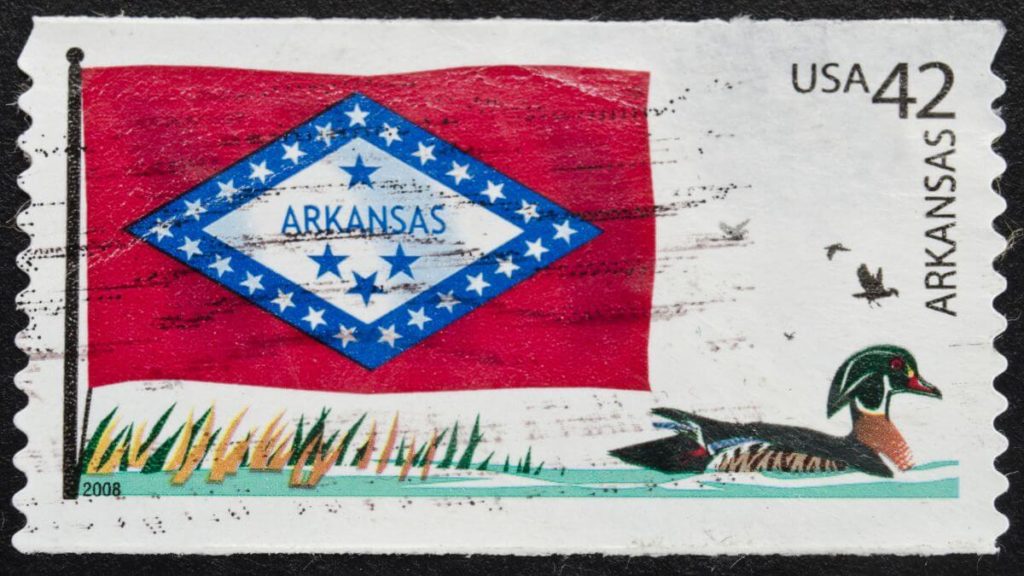
Living or visiting Arkansas and wondering what bird you’re looking at? This article covers common birds of Arkansas. Odds are high the bird you’re looking at is one of them. It will also inform you on how to identify them.
Most Common Birds of Arkansas
Arkansas is an excellent state for birding. The state’s many marshlands provide a home for herons and egrets. There are two large forests and reservoirs for water birds and even some prairie land. There are several wildlife refuges created specifically for waterfowl.
Southern Arkansas has the most birding possibilities, with the ever-popular Red-cockaded Woodpecker, Brown-headed Nuthatch, and Bachman’s Sparrow, as well as other breeds of birds, such as the Wood Stork or Western Kingbird.
Migrating Cape May Warblers and Black-throated Blue Warbler can be seen in southeastern Arkansas in the spring. Also in the southeast, Millwood Lake hosts several species of rare birds, waterfowl, and gulls. Spotting rarities such as the Magnificent Frigatebird or Sooty Tern is a treasure for any birder.
While at the lake, Beards Bluff is an excellent viewing site, as is the Ouachita National Forest by Highway 71, where there are more Red-cockaded Woodpeckers and Bachman’s Sparrow, and many others.
The Holla Bend National Wildlife Refuge in Central Arkansas is home to 270 different bird species. The purpose of the refuge is to create a haven for migrating ducks and geese each winter. Up to 100,000 of them seek refuge here, as do the Bald Eagles during the winter months.
In the winter, Lake Dardanelle State Park off Highway 22 hosts an abundance of waterfowl, such as the Common Goldeye, Ring-necked Duck, Barrow’s Goldeneye, and White-winged Scoter, and many others.
Arkansas’s most common birds are as follows…
Northern Cardinal

The Northern Cardinal is a breathtaking, red-colored bird with a short pink bill that can be found in Arkansas all year long. They grow between 8.3 and 9.1 inches in length and weigh 1.19 to 2.29 ounces. Their wingspan in 9l8 to 12.2 inches.
It can be found in parks, gardens, and other urban areas. This fascinating scarlet avian will visit birdfeeders looking for sunflower seeds. Its natural diet consists of small fruits, berries, and insects.
Blue Jay

The Blue Jay in Northwest Arkansas is the most attractive of the various bluebirds. They are medium sized with a wingspan of 15 to 16 inches and weigh between 2.5 and 3.75 ounces. They are gorgeous while at the same time may act aggressively – the Mean Girls of the avian world.
Their feathering is a striking blue with a white underbelly and black beak, and the crest on their head is blue. They feed on seeds, berries, nuts, acorns as well as insects and spiders and feel comfortable enough around humans to feed at bird feeders. They usually make their home in deciduous or coniferous forests, but can be found in towns, as well.
Tufted Titmouse
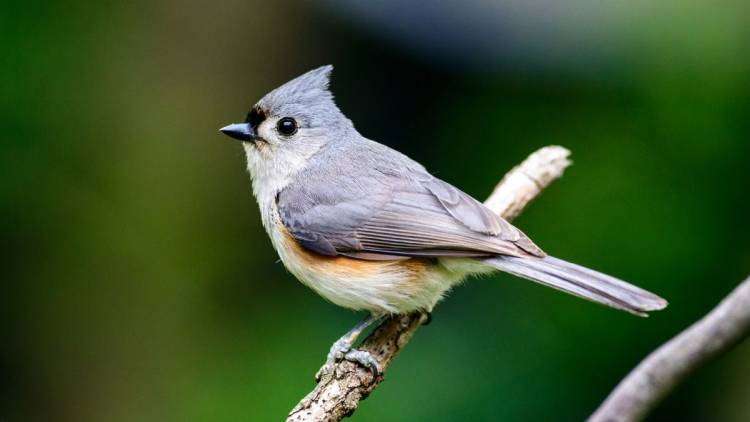
The Tufted Titmouse lives in woodlands, river basins, and forest edges and can also be found in parks or orchards. They have mouselike grey feathers with a white front and a tufted gray crest.
They will grow to 5.5 to 6.5 inches and weigh 18 to 26 grams. Their major diet consists of nuts, seeds, fruit, berries, and insects.
Northern Mockingbird
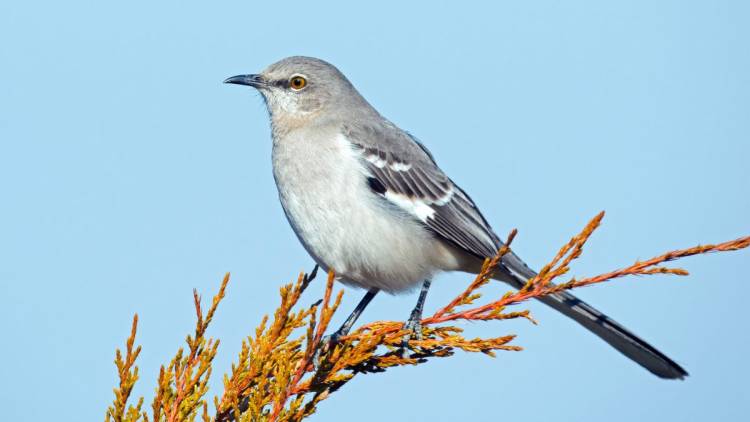
The Northern Mockingbird is the official State Bird of Arkansas. They live in the state year-round in shrubs, gardens, and trees. It is gray with a white chest, like the Tufted Titmouse, but it lacks the gray crest and has a blackish tail and a black beak. The Mockingbird’s eyes are orange and lined in black or brown. Their wingspan is 14 inches, and they weight1 ¾ ounces.
They are talented songbirds, with the unmated males singing the most, especially at night, probably to catch the attention of a potential mate. Mated males will sting in defense of their territory.
The Northern Mockingbird’s diet consists of insects, seeds, and berries.
Red-winged Blackbird
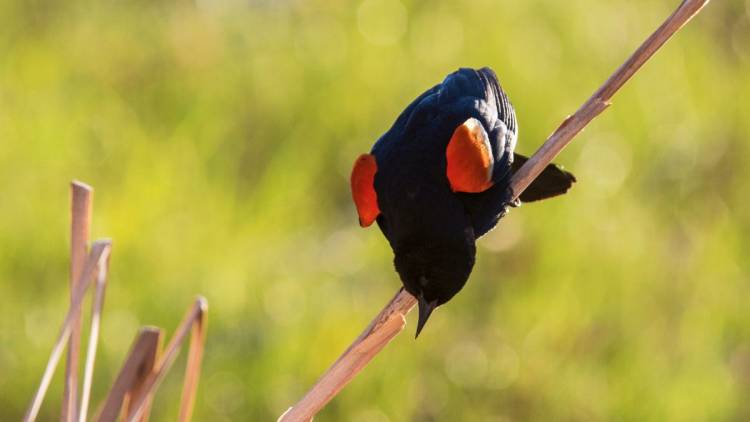
The Red-winged Blackbird can be found in the lower Mississippi Valley area of Arkansas at the edge of forests. The male is dressed to impress with a glossy black body and extravagant red epaulets on each shoulder. The males are rascally and may breed with as many as 15 females. The female, as if not daring to compete, is a simple lackluster gray-brown. She resembles a sparrow, but at almost 8 inches, is much larger.
They grow in size from 6.7 to 8.00 in length and weigh between 41.5 and 65 grams.
Their diet consists of grain and seeds; in the summer, however, they subsist mostly on insects, beetles, spiders, and caterpillars. They will visit bird feeders for millet, cracked corn, and sunflower seeds.
Red-headed Woodpecker
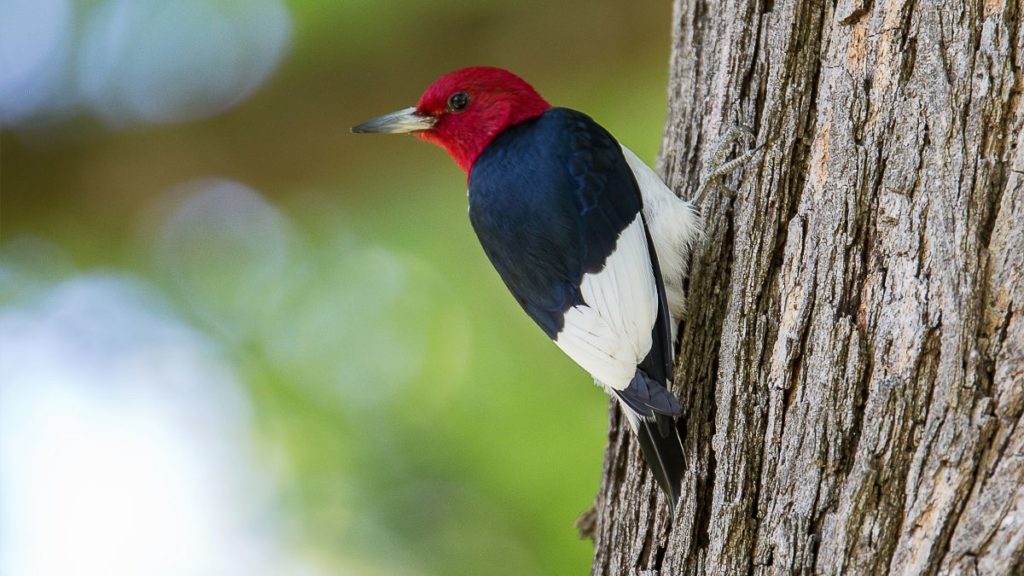
The Red-headed Woodpecker stands out with its bold red head, black wings, and a white underbelly with a short tail. It grows from 7.5 to 9.1 inches in length and weighs between 2.0 and 3.2 ounces. Its wingspan is 16.5 inches.
They live on farms, dead swampland timber, or pine forests. The Red-headed Woodpecker can be lured to bird feeders with an offering of suet.
Brown-headed Cowbird
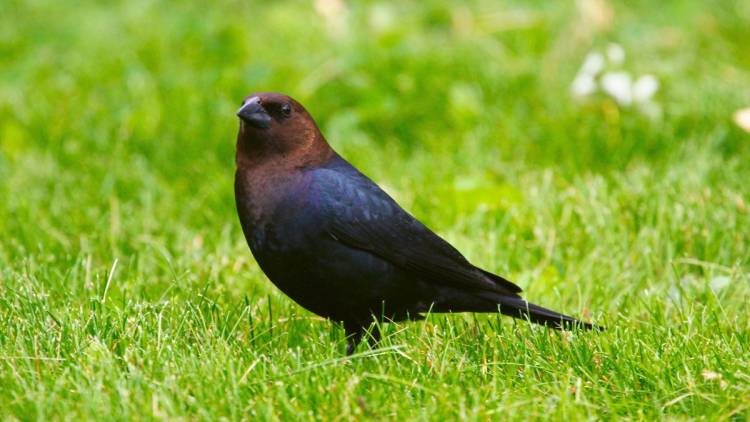
The Brown-headed Cowbird is stocky with a conical bead. The male has a lush black body with a brown head and short tail, while the female is an ordinary brown. As a matter of fact, the female Brown-headed Cowbird is one of the most difficult Arkansas birds to identify because she lacks any distinctive markings. The months of March and July are the best for spotting them.
They grow between 7.6 and 8.7 inches long and weigh between 1.3 and 1.8 ounces with a 14.2-inch wingspan. They may be found on the edges of woodland and prairies, but they also live in pastures, orchards, and cemeteries.
A distinguishing feature of the Brown-headed Cowbird is that they are brood parasites. The female lays her eggs in other birds’ nests and lets other birds raise them.
Summer Tanager
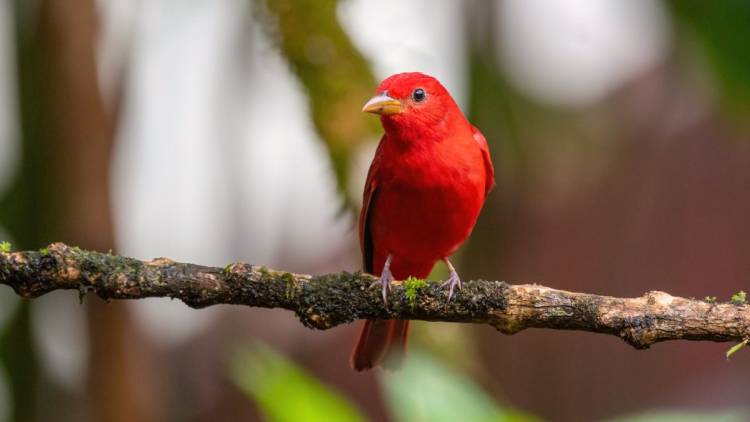
While the Summer Tanager is a year-round resident of Arkansas, it can be seen most frequently between April and October. Many head south for the winter. The male and the female don’t look as if they are related – the male is a gorgeous red while the female is a bright yellow.
They grow to 6.7 inches in length and weigh 1.1 ounce.
The Summer Tanagers live in open woodlands and catch bees and wasps in the air. They perch on the top of trees and can be difficult to spot, but they will visit backyards with fruit trees and berries.
Common Birds of Arkansas by Color
Black Birds in Arkansas
European Starling
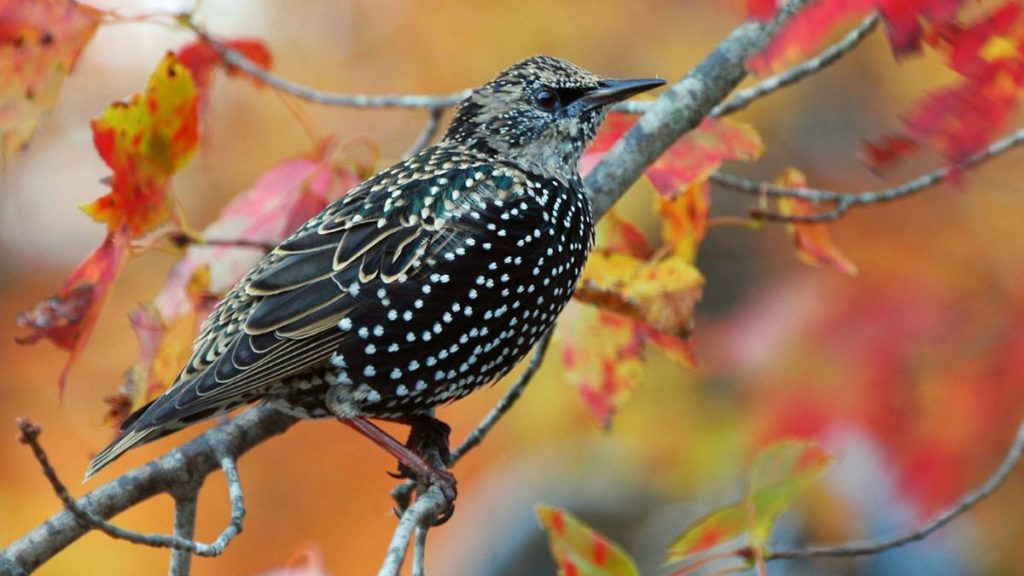
The European Starling is an extraordinarily exotic type of blackbird. It weighs 3 ounces and grows from 7.9 to 9.1 inches in length with a wingspan from 12.2 and 15.8 inches. It is stocky with more luxurious iridescent purple and green feathers than black.
In Arkansas, the Europeans Starling can be found on farms and in urban settings. They will forage in fields, pastures, and parks.
Yellow-headed Blackbird

The stunning Yellow-headed Blackbird has a shiny black body with a large yellow head, a long tail, and a sharp bill. They grow 8.3 to 10.2 inches long and weigh between 1.6 and 3.5 ounces. Their wingspan reaches from 16.5 to 17.3 inches. They feed on insects and seeds.
White-throated Sparrow
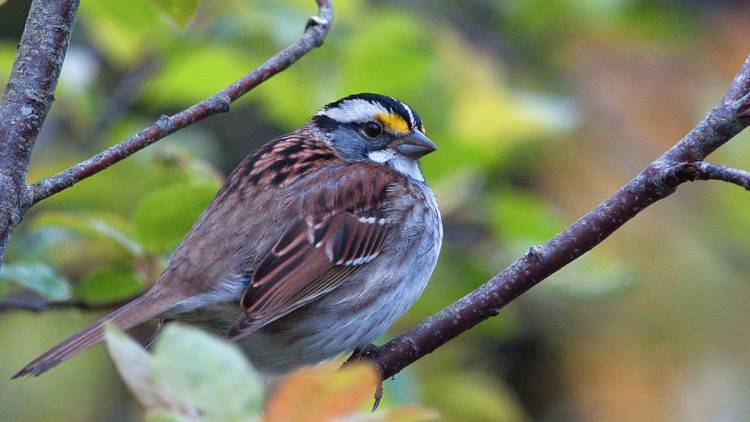
The White-throated Sparrow is one of the most spotted birds in Arkansas during October and May. They have a black and white striped head, white throat, and yellow coloring between the eyes that resemble bright eyebrows. Their wings are a stripped brown or white with a gray underbelly.
They grow 6.3 to 7.1 in length and weigh between .8 to 1.1 ounces. Their wingspan ranges from 7.9 to 9.1 inches. They like to live on the edges of forests, where they feed on seeds and small berries as well as insects.
Great-tailed Grackle
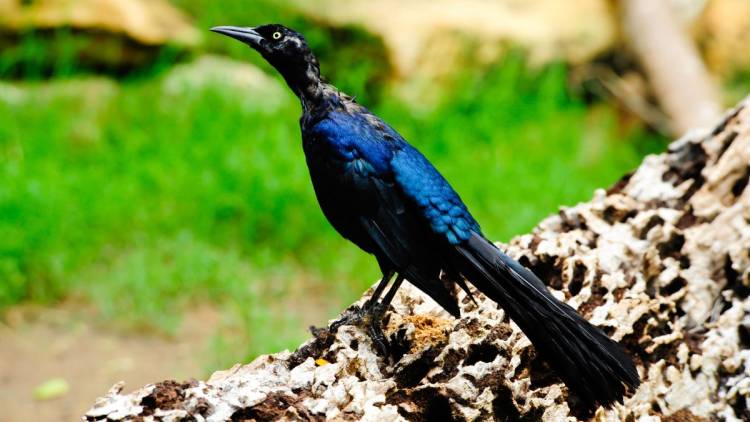
The Great-tailed Grackle can be found in western Arkansas throughout the year, mostly high up in trees in mangroves or suburban areas. They are slender with a beautiful black body and long tails for the male. The female is a browner color.
They grow between 15 and 18.1 inches in length and weigh between 3.7 and 6.7 ounces with a wingspan between 18.9 and 22.8 inches. The male is approximately 60 percent heavier than the female.
They feed on grains, seeds, fruits, insects, and worms.
Blue Birds in Arkansas
Eastern Bluebird in Arizona
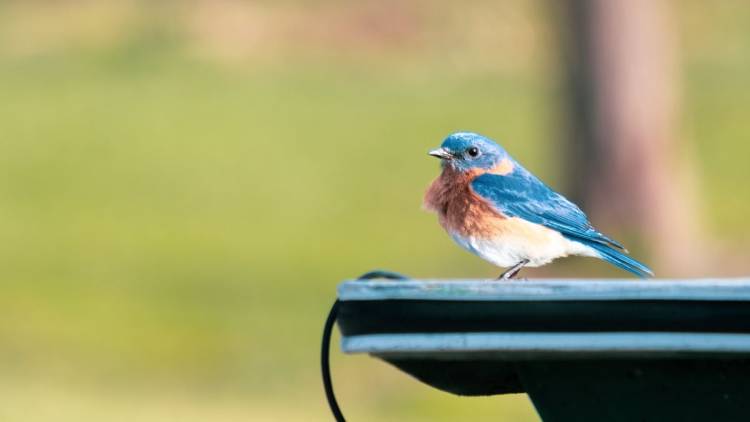
The Eastern Bluebird is the only true bluebird in the State of Arizona. They have a blue and orange breast and a white belly and undertail, with the female’s color a more muted shade.
They feed on insects and spiders, and in the winter, they search for small fruit. To attract them to a birdfeeder, lay out suet, dried fruit, and sunflower seeds. The Eastern Bluebird can mostly be found in open fields, golf courses, cemeteries, and meadows, but they like to nest in manmade nesting boxes. In Hot Springs Village, there are 300 nesting boxes on 9 different golf courses.
The Eastern Bluebirds grow between 6.3 and 8.3 inches long, weigh .95 to 1.20 ounces, and have a wingspan of 9.8 to 12.6 inches.
Indigo Bunting
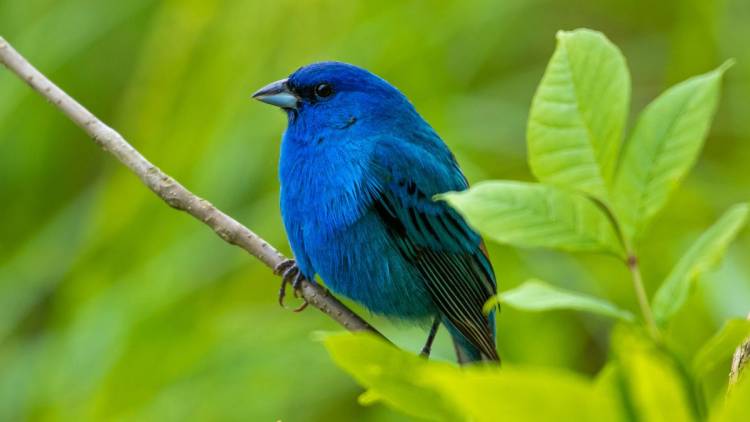
The male Indigo Bunting is a small but stunning blue bird with a grayish bill. The blue becomes even brighter during the breeding season. As it so often happens in the avian world, the female is a basic brown with a small patch of blue on her wings. They are small birds that grow up to 4.5 inches and have a wingspan up to 9 inches.
Indigo Buntings feed on insects, seeds, and berries. They will visit a backyard if they can get thistle or Nyjer seeds. They live in bushy areas. When not perched on something tall, they will forage in shrubs and grass.
Black-throated Blue Warbler
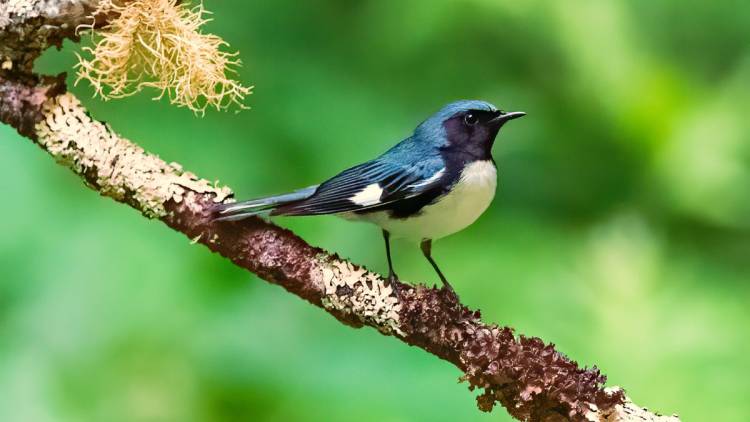
The male Black-throated Blue Warbler is a deep blue with a white underbelly and a black throat and face. The female is a grayish version. Both male and female have a white square located on the wing, like a dressy pocket-handkerchief.
They weigh between 0.3 and 0.4 ounces and grow between 4.3 and 5.1 in length, with a wingspan of 7.5 to 7.9.
They like to live in deciduous-coniferous forests with plenty of shrubs while snapping up insects among the foliage. During the winter months, they expand their diet to include seeds and berries.
Orange Birds in Arkansas
American Robin

The American Robin can be spotted year-round in Arkansas, usually in gardens, parks, golf courses, fields, and deciduous forests. They feed on earthworms and insects during the summer, while they eat fruits and berries in the winter. They do not eat seeds.
This robin grows between 9 and 11 inches long and weighs between 2.3 and 3 ounces with a wingspan of 14 ¾ inches to 16 ½.
Baltimore Oriole
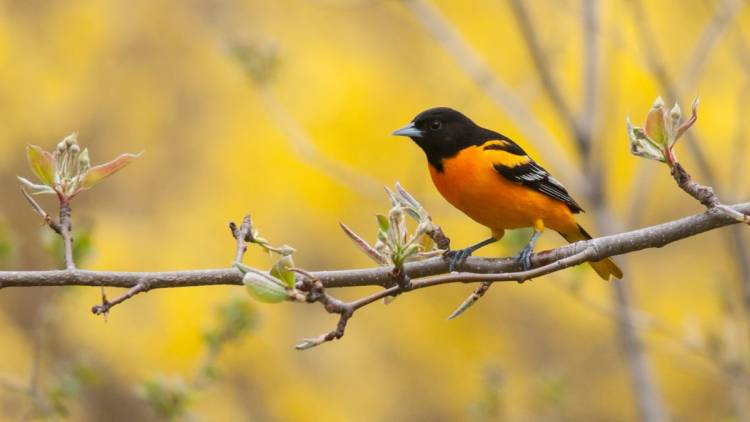
The Baltimore Oriole is a sturdy songbird with long legs and thick bills. The male is bright orange and black with a black head and a white stripe across the back. The female is more of a yellow-orange with a gray head. She, however, has 2 white stripes across her back.
These birds grow 6.7 to 7.5 inches in length and weigh between. 1.1 and 1.4 ounces with a wingspan of 9.1 to 11.8 inches.
The Baltimore Oriole lives in deciduous trees at the edges of forests, in orchards, parks, and in trees near rivers. They are easily lured to bird feeders with fruits such as bananas or berries. They cannot resist grape jelly.
The Baltimore Oriole breeds with the Bullock Oriole and recognizing their offspring can be a genuine challenge for birders.
Red-breasted Nuthatch

The Red-breasted Nuthatch is a blue-gray bird with a rusty underbelly and a black cap. The eye has a stripe that gives the appearance of eyeliner. This bird grows to 4.3 in length and weighs between 0.3 to 0.5 ounces with a wingspan between 7.1 to 7.9 inches. They are sturdy, with no neck and a short tail.
They feed off conifer seeds and insects and will come to backyard bird feeders for sunflowers.
Birders searching for the Red-breasted Nuthatch need to check the coniferous woods and mountains of Arkansas.
Yellow Birds in Arkansas
American Goldfinch

The American Goldfinch can be found in southern and central Arkansas from November through May. They live year-round in the northern part of the state. Their vivid yellow and black coloring is difficult to miss. The female, of course, is a few shades duller than the male.
The American Goldfinch grows between 4.3 and 5.1 inches in length and weighs between 0.4 and 0.7 ounces, with a wingspan between 7.5 and 8.7 inches.
Goldfinches can be found in Arkansas’s central region. They will eat seeds and build their nests in shrubs.
Eastern Meadowlark
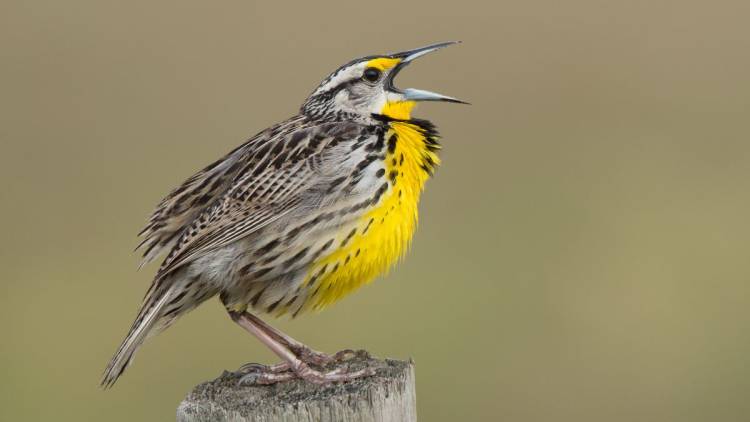
The Meadowlark is a medium-sized songbird that lives in Arkansas all year.
Eastern Meadowlarks grow from 7.5 to 10.2 inches in length and weigh between 3.2 and 5.3 ounces with a wingspan between 13.8 and 15.8 inches. They have a yellow underside and brown markings on their back. Their most distinctive feature is the V-shaped black stripe across their chest.
They live in prairies and grassland, where they feed on seeds. Their singing is very melodic.
Pine Warbler
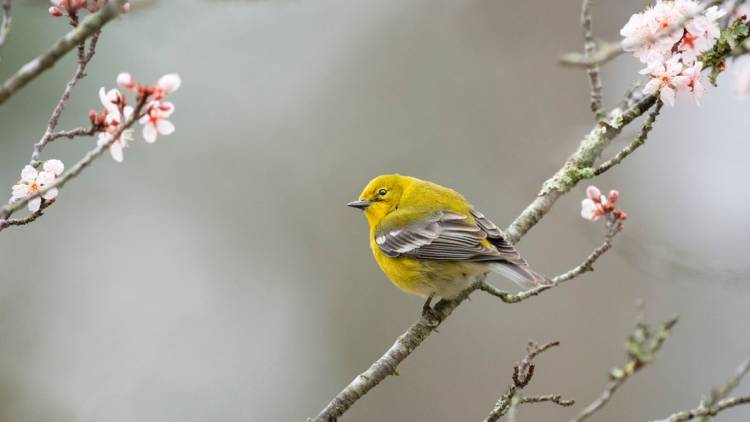
The Pine Warbler lives in Arkansas year-round. They are plump little yellow birds with olive-green backs, white bellies, and gray wing bars. The female may lean more toward brown than yellow. They are found mainly in pine forests, but sometimes, they will nest in cedar trees.
They are attracted to bird feeders with suet. Otherwise, they feed on seeds and insects.
They grow between 5.1 and 5.5 inches in length, weigh between 0.3 and 0.5 ounces with a wingspan of 7.5 and 9.1 inches.
Common Birds of Arkansas by Species
Herons in Arkansas
Great Blue Heron – Ardea Herodias – resides in the wetlands, rivers, and lakes of Arkansas. It is a tall, gray-blue bird, with a black stripe over the eye and a long neck. They have long plumes on the back, head, and neck.

They feed on fish, birds, and frogs; they may even stalk gophers in a field.
Green Herons – Butorides virescens – are small herons that grow up to 14 inches with a wingspan of 25 inches and have a long bill. The male has a bluish color, while the top of their head is brown with a green sheen. Their necks are brown with a white stripe.
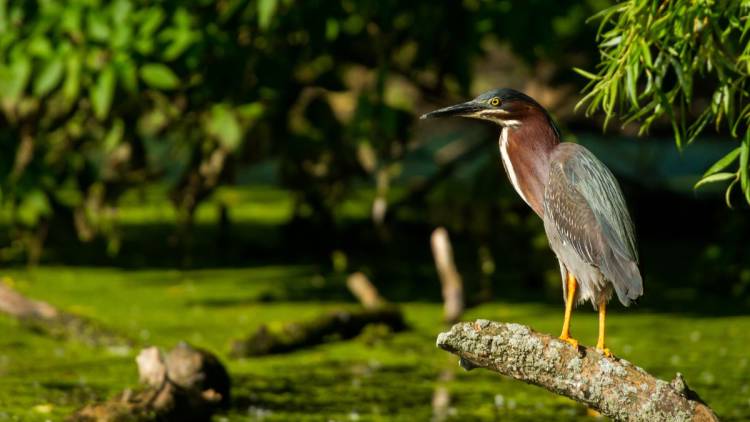
They eat fish, insects, snakes, worms, and small rodents. They are sneaky and will drop feathers or insects into the water to entice fish to come and investigate.
In Arkansas, the Green Herons can be seen in DeGray Lake Resort State Park and by the banks of the Little Arkansas River
Least Bittern – Ixobrychus exilis – is the smallest of the heron species, growing to a mere 13 inches in length with a wingspan of 17 inches. They weigh around 3 ounces. Their wings are streaked black, chestnut, and buff, and their long throat is chestnut and buff. The crown, nape, back, and tail are a blackish green while the underbelly is chestnut and white. The female lacks a colorful appearance and is mainly brown.
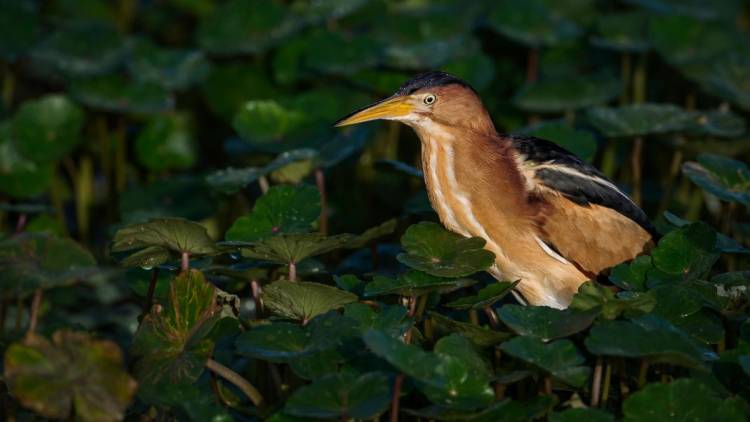
They feed on crustaceans, fish, insects, and small amphibians.
Hawks in Arkansas
Cooper’s Hawk – Accipiter cooperii – the adults are blue-gray with red bars around the underbelly and dark bars on the tail. They can be found in Arkansas all year near woodland and forests. They go after larger birds, such as doves, chickens, and starlings, for food. During the wintertime, they will visit bird feeders for suet and seeds.

A rarity in the bird world, the female Coopers Hawk is larger than the male. The male grows between 14.6 and 15.3 inches in length with a wingspan between 24.4 and 35.4 inches. The female grows between 16.5 and 17.7 inches in length and weighs between 11.6 and 24 ounces, with a wingspan between 29.5 and 35.4 inches.
Red-tailed Hawks live in Arkansas throughout the year. They feed on mice, rabbits, snakes, and other birds.
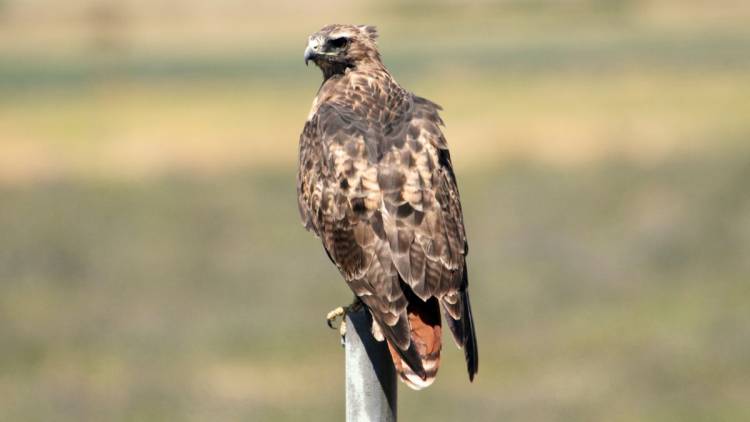
Again, the male is smaller than the female. The male grows between 17.7 and 22.1 inches and weighs between 24.3 and 45.9 ounces with a wingspan between 44.9 and 52.4 inches. The female grows between 19.7 and 25.6 inches and weighs between 31.8 and 51.5 ounces with a wingspan between 44.9 and 52.4 inches.
The Red-tailed Hawks are brown on top and a paler color below, with streaking on the belly and wing underside and a dark bar between the shoulder and wrist. It gets its name from its reddish tail. They inhabit open country such as fields and frequently perch on fences, telephone poles, or trees near the fields. Like most other hawks, the Red-tailed Hawk feeds on rats, rabbits, squirrels, voles, and other birds.
Swainson’s Hawk is a large hawk, growing 18.9 to 22.1 in length and weighing between 24.4 and 48.2 ounces. Their feathers are various shades of dark, and their underbelly is a shiny white. They have a short tail.
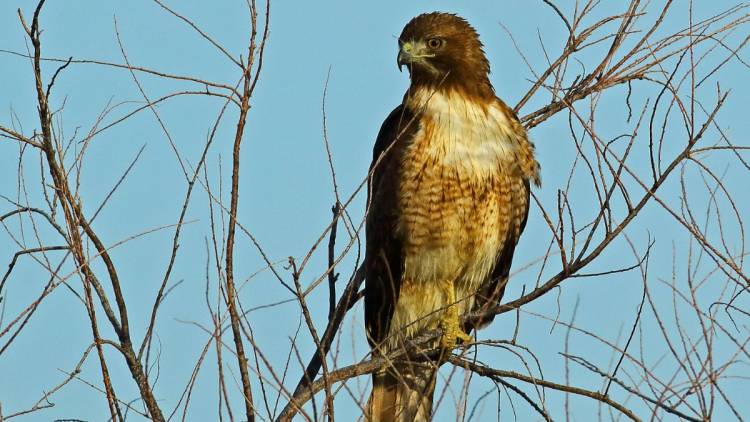
They live in open grassland, perching on high trees to spot potential preys, with a special interest in snakes, mice, rabbits, crickets, and lizards. They are becoming rare in Arkansas and a special prize for birders.
Owls in Arkansas
Eastern Screech Owl is a small owl the approximate size of a robin. Its brown coloring helps it remain inconspicuous while perched on trees. It grows between 6.3 and 9.8 inches in length and weighs between 4.3 and 8.6 ounces with a wingspan between 18.9 and 24 inches. The Eastern Screech Owl can be found in Arkansas throughout the year. It feeds on rodents and smaller birds.

The Great Horned Owl is a large owl (the largest in Arkansas) with brown and white stripes on their wings and underbelly with ear tufts and yellow eyes. It can be found in Arkansas throughout the year. It grows between 18.1 and 24.8 in length, and weighs between 32.1 and 88.2 ounces with a wingspan between 39.8 and 57.1 inches. They are fierce and are known to attack other predator birds such as the Red-tailed Hawk. Generally, they feed on rabbits, mice, frogs, groundhogs, and geese.
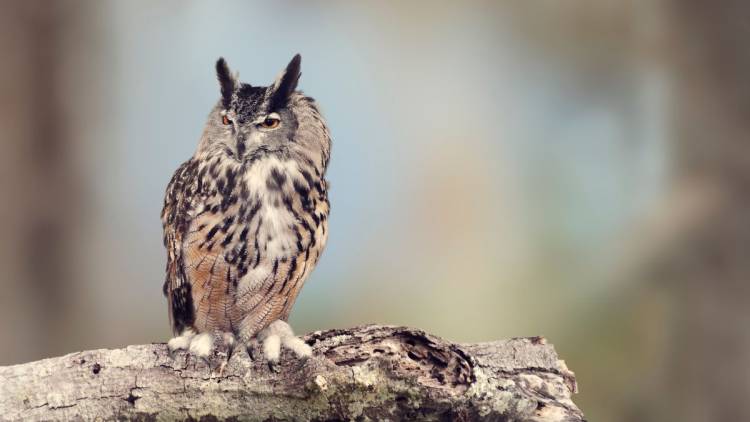
Short-eared Owl lives in open fields and prairies and hunts both at night and during the day. In Arkansas, they can be found in the Grand Prairie, located in eastern Arkansas by the Mississippi River Delta. Mostly, they feed on other birds and small mammals.

They grow to 13.4 to 16.9 in length and weigh 7.3 to 16.8 ounces with a wingspan of 33.5 to 40.5 inches.
Additional Resources and Further Reading
More information on Arkansas birds can be found at:
You can also read more about common birds of Arkansas, and Arkansas birding in general, with the following books.
- Tekiela, Stan (Author)
- English (Publication Language)
- Greg. R. Homel (Author)
- English (Publication Language)
Did we miss any common birds? Did you find the bird you’re looking for? Let us know in the comments section.


